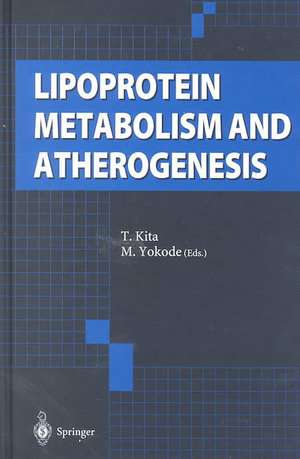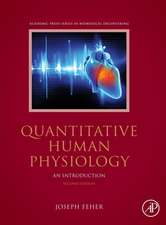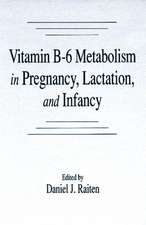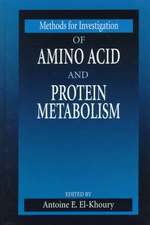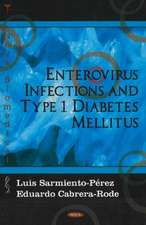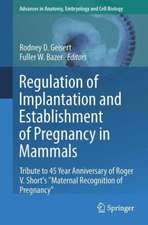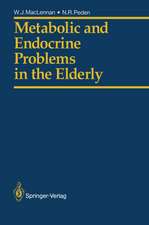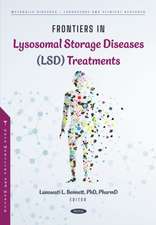Lipoprotein Metabolism and Atherogenesis
Editat de T. Kita, M. Yokodeen Limba Engleză Hardback – 31 aug 2000
| Toate formatele și edițiile | Preț | Express |
|---|---|---|
| Paperback (1) | 369.10 lei 6-8 săpt. | |
| Springer – 24 feb 2012 | 369.10 lei 6-8 săpt. | |
| Hardback (1) | 376.22 lei 6-8 săpt. | |
| Springer – 31 aug 2000 | 376.22 lei 6-8 săpt. |
Preț: 376.22 lei
Preț vechi: 396.02 lei
-5% Nou
Puncte Express: 564
Preț estimativ în valută:
71.100€ • 78.18$ • 60.48£
71.100€ • 78.18$ • 60.48£
Carte tipărită la comandă
Livrare economică 22 aprilie-06 mai
Preluare comenzi: 021 569.72.76
Specificații
ISBN-13: 9784431702610
ISBN-10: 443170261X
Pagini: 304
Ilustrații: XVIII, 283 p.
Dimensiuni: 155 x 235 x 22 mm
Greutate: 0.6 kg
Editura: Springer
Colecția Springer
Locul publicării:Tokyo, Japan
ISBN-10: 443170261X
Pagini: 304
Ilustrații: XVIII, 283 p.
Dimensiuni: 155 x 235 x 22 mm
Greutate: 0.6 kg
Editura: Springer
Colecția Springer
Locul publicării:Tokyo, Japan
Public țintă
ResearchDescriere
Atherosclerosis leading to coronary heart disease and to cerebrovascular disorders is the number one cause of death in industrialized societies. For the last two decades, great ad vances have been made in understanding the pathogenesis of those disorders. Recent studies have revealed that the earliest event in atherogenesis is the adhesion of circulating leukocytes to the vascular endothelial cells and their migration into the subendothelial space. These cells are known to playa central role in the formation of a fatty streak consist ing of lipid-laden foam cells. As pathological events continue, the lesion is converted to a more fibrous lesion associated with vascular smooth muscle cells. To solve the enigma of this complicated process, intensive studies in molecular biology have disclosed the genes involved in those events. Some of the genes have been verified by creation of novel animal models, which have led to novel therapeutic strategies for subjects with atherosclerosis. This volume contains papers presented at the International Symposium on Lipoprotein Metabolism and Atherogenesis held in Kyoto December 5-8, 1998, supported in part by the Japan Intractable Diseases Research Foundation. The following three topics were the focus of the three-day program: I) The molecular approach to studying risk factors and prevention 2) The creation of novel animal models 3) Lipoprotein disorder as a cause of activation of vascular endothelial cells Thirty distinguished researchers from the United States, the United Kingdom, Austria, Finland, Australia, and Japan were invited.
Cuprins
1: The Molecular Approach to Risk Factors and Prevention.- Lipoprotein Metabolism and Atherogenesis.- Role of Lipid Concentrations and Apolipoproteins in Altering ApoB Metabolism and Promoting Coronary Events.- Long-Term Effect of LDL-Apheresis on Familial Hypercholesterolemia Homozygotes.- Molecular Mechanism of Visceral Obesity.- Diabetes and Atherosclerosis.- 2: The Molecular Basis of Lipoprotein Metabolism (I).- Molecular Genetics and Clinical Features of Japanese Patients with Familial Hypercholesterolemia.- Molecular Analysis of Apolipoprotein A-I and E Mutants in Japan.- Novel Mutations of the LDL Receptor Gene in Familial Hypercholesterolemia Pedigrees in Hokkaido.- Preheparin Lipoprotein Lipase Mass Might Reflect the Amount of Working Lipoprotein Lipase in the Whole Body.- Quantitative Trait Loci (QTLs) for Serum Cholesterol Levels in the Stroke-Prone Spontaneoulsy Hypertensive Rats (SHRSP).- Evidence of Linkage in Familial Combined Hyperlipidemia to Chromosome lq21-q23.- Molecular Analysis on the LDL Receptors in Two Patients with Homozygous Familial Hypercholesterolemia.- Common Mutation of 5, 10-Methylenetrahydrofolate Reductase Accelerates Coronary Artery Disease in Familial Hypercholesterolemia.- Effect of Troglitazone on Plasma Lipid Metabolism and Lipoprotein Lipase.- Combination of LPL Gene Exon 9 Ser447 ? Ter Nonsense Mutation and Apo ?2 Allele Might Contribute to Development of Hypertriglyceridemia.- Improvement by Thiazolidinediones of Vascular Endothelial Cell Dysfunction in Diabetic Patients: A Possible New Physiological Role of PPAR?.- Beneficial Effect of Gemfibrozil on LDL Chemicophysical Characteristics and Oxidizability.- Inhibitory Effect of HMG-CoA Reductase Inhibitors for the Development and Progression of Intimal-Medial Thickness in Carotid Artery in Type 2 Diabetes Mellitus with Hypercholesterolemia.- Plasma Phosphatidylcholine Hydroperoxide Concentrations in Normal Subjects and Patients with Hyperlipidemia.- 3: The Moleculer Basics of Lipoprotein Metabolism (II).- Lipid Transfer Proteins and Receptors in HDL Metabolism.- PPARs and Atherosclerosis.- Molecular Basis of Cellular Cholesterol Efflux and Regulation of Plasma HDL Level.- Roles of Apolipoprotein E Receptors in Lipoprotein Metabolism.- The Structure and Function of the Scavenger Receptor Class A.- Impairment of Reverse Cholesterol Transport System and Atherosclerosis.- ACAT Genes and Proteins in Humans.- Caveolin is Cholesterol-Binding Protein.- In Vivo Functions of SREBPs.- Molecular Characterization of Arachidonate Preferring Acyl-CoA Synthetase, ACS4.- Molecular Characterization of Short-Chain Acyl-CoA Synthetases.- Expression of the VLDL Receptor is Up-Regulated by Cell Differentiation in HL-60 Cells.- Transcriptional Regulation of the Genes for Human HMG CoA Synthase and Squalene Synthase by SREBP and NF-Y.- Expression of Acyl-Coenzyme A: Cholesterol Acyltransferase-1 (ACAT-1) Protein in Human Atherosclerotic Lesions and Cultured Monocytes-Macrophages.- Relationship Between Postprandial Triglyceride Level and Intima-Media Thickness of Carotid Artery After Troglitazone Treatment in Type 2 Diabetes.- A New Rabbit Strain with Heritable Hypercholesterolemia and Hypertriglyceridemia.- Turnover of Glutathione and Ascorbic Acid is Suppressed in Hyperlipidemic Rabbits.- Pravastatin, an HMG-CoA Reductase Inhibitor, is Transported by Rat Organic Anion Transporting Polypeptide, oatp2.- 4: The Search for the Link Between Lipoprotein Metabolism Disorder and Atherogenesis (I).- The Puzzling Ligands for Scavenger Receptors.- Granulocyte Macrophage Colony-Stimulating Factor is Involved in Murine Macrophage Proliferation Induced by Oxidized Low Density Lipoprotein.- Mast Cells in Atherogenesis: A Model for Studying Proteolytic Modification of Low and High Density Lipoproteins.- LOX-l, an Endothelial Receptor for Oxidized LDL — Implications for Induction of Endothelium Dysfunction in the Pathogenesis of Vascular Diseases —.- Inducible Expression of Lectin-Like Oxidized Low Density Lipoprotein Receptor-1 in Vascular Endothelial Cells and Macrophages.- Identification and Characterization of a PDZ Domain-Containing Protein that Interacts with the HDL Receptor SR-BI.- Structure and Function of Human SREC (Scavenger Receptor Expressed by Endothelial Cells), A Novel Receptor for Modified LDL.- The Role of CD36 in Atherogenesis as a Receptor for OxLDL.- Apoptosis in Atherosclerosis: Induction of Apoptosis by Oxidized Low Density Lipoprotein and Oxysterols.- Combination Treatment with an Insulin Action Enhancer and an Inhibitor of HMG-CoA Reductase Shows a Synergistic Effect on Atherosclerosis of WHHL Rabbits.- Reduced Secretion of Tumor Necrosis Factor-? and Interleukin-1 ? from Monocyte-Derived Macrophages of CD36-Deficient Subjects in Response to Oxidized LDL.- CD36 Expression in Human Monocytic Leukemia Cell Lines: THP-1 and THP-1 Subtype, Show Different Expressions of Type I and Type II Scavenger Receptors.- 5: The Search for the Link Between Lipoprotein Metabolism Disorder and Atherogenesis (II).- Alteration of Smooth Muscle Cell Phenotype in Diabetic Vascular Wall: From the Molecular Point of View.- The Vascular Nitric Oxide/Superoxide System and Atherosclerosis.- Antagonistic Monoclonal Antibody Against Receptor Tyrosine Kinases: A Novel Strategy to Study the Role of Monocyte/Macrophage in Atherogenesis In Vivo.- Rac l and CDC42Hs Play a Critical Role in MCP-1-Induced Chemotaxis.- Stimulation of Mitogen-Activated Kinases by Lysophosphatidylcholine in Bovine Aortic Endothelial Cells.- Ca2+-Dependent Activation of the 33-kDa Thrombin Receptor-Associated Kinase in Human Platelets.- Lysophosphatidylcholine Generates Superoxide Anios Through Activation of Phosphatidylinositol 3-Kinase in Human Neutrophils.- PDGF Enhanced 7-Ketocholesterol-Induced Apoptosis of Vascular Smooth Muscle Cell, Accompaning with c-myc Expression.- Adventitia-Derived Macrophages Contribute to the Formation of Coronary Arteriosclerotic Lesions in Pigs In Vivo — Potentiating Effect of Oxidative Stress —.- Expression of CD36 in Cultured Human Aortic Smooth Muscle Cells (HASMCs).- Induction of Macrophage VEGF in Response to Oxidized LDL and VEGF Accumulation in Human Atherosclerotic Lesion.- F-1394, an ACAT Inhibitor, Inhibits Neointimal Thickening and Macrophage Accumulation After Balloon Injury in the Cholesterol-Fed Rabbit.- Key Word Index.
Caracteristici
Presenting the exciting results of research in the areas of the molecular basis of lipoprotein metabolism,
the link between lipoprotein metabolism disorder and atherogenesis, and the molecular approaches to risk factors and prevention
the link between lipoprotein metabolism disorder and atherogenesis, and the molecular approaches to risk factors and prevention
